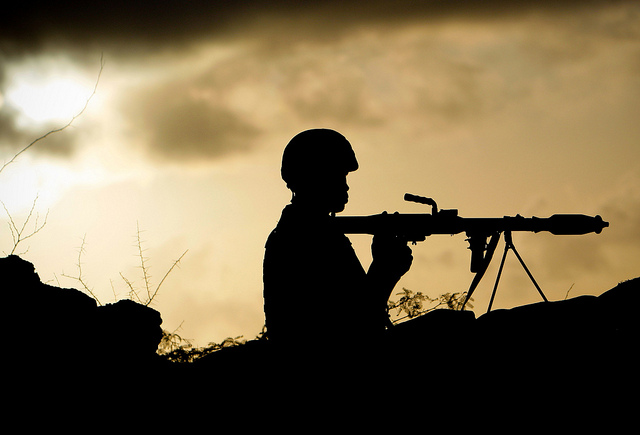Somalia’s 9/11

On 12 October, Mogadishu was rocked by a powerful bomb that killed more than 320 people and injured around 500. Security officials attribute the bombing to al-Shabaab (‘the youth’), although the group has yet to claim responsibility.
The bombing involved two vehicles: a truck that was packed with 350 kilograms of homemade and military-grade explosives and a minivan. The target was apparently the airport compound where the United Nations, several foreign embassies and the African Union Mission in Somalia (AMISOM) are based. The plan was for the minivan to blow up the checkpoint, which would then allow the truck through, but the truck was stopped at the checkpoint. As it was about to be searched, the driver accelerated, crashing through a barrier before detonating the charge next to a fuel tanker. Perhaps al-Shabaab didn’t expect so many casualties, which may explain why the group hasn’t claimed responsibility for the attack.
The truck allegedly came from Bariire, an al-Shabaab stronghold about 50 kilometres west of Mogadishu. In May, a US Navy Seal died in a raid on an al-Shabaab compound in Bariire. It’s been alleged that the bombing was a revenge attack for a failed US Special Forces operation in August in which 10 people died, including three children. Abukar Osman Sheikh, a clan elder, reportedly said, ‘Last year, the US killed my people in Galkayo in a deliberate strike … We shall no longer tolerate it.’
This latest atrocity demonstrates that Africa has increasingly become a central battleground for salafi-jihadi activity, which killed more than 33,000 people between 2011 and 2016.
Earlier this year, al-Shabaab—which has been under pressure from AMISOM and an energised US-led drone campaign—vowed to increase its attacks, primarily against the newly formed government of Mohamed Abdullahi Mohamed. Mohamed is a dual US–Somali national who became president in February with a promise to defeat al-Shabaab and address many of Somalia’s structural problems.
Poor security meant that Somalis couldn’t vote directly for their president. The matter was left to 14,025 elders and prominent regional figures who come from 135 clans and subclans. They selected 275 MPs and 54 senators, who were then offered the choice of either giving Hassan Sheikh Mohamud a second term or opting for one of 21 rivals. There are reports that bribes ranging from US$1,000 to US$1.3 million were offered to secure votes.
It is evident that security is a problem in Somalia and particularly in Mogadishu, which has an average of two large bombings per month, as well as shootings, kidnappings and roadside bombings. This is despite the presence of 20,000 AMISOM troops, coupled with President Donald Trump’s decision to designate Somalia as an ‘area of active hostilities’, which means that for 180 days US commanders have more flexibility when deciding when, where and against whom to launch airstrikes. Previously, they were limited to supporting partner forces. The order did not cover Mogadishu.
Al-Shabaab has been running a vicious campaign against the Somali government and against AMISOM, which it portrays as a US-backed foreign force that operates illegally in Somalia. AMISOM grew out of the ill-fated 2006 US-backed Ethiopian intervention, which sought to topple the Islamic Courts Union, which Washington and Addis Ababa saw as a terrorist organisation. AMISOM was supposed ‘to support a national reconciliation congress’, but it quickly assumed the role of a counterinsurgency force aimed at defeating al-Shabaab.
In the early 2010s, Somali watchers noted that AMISOM, which costs around a billion dollars a year, was running an effective counterinsurgency and counterterrorism campaign against al-Shabaab. Consequently, AMISOM has become a stakeholder in the conflict, as it plays a vital role in propping up the Somali government. It’s supposed to leave once the government can ‘stand on its own’.
It has become apparent that deep structural problems within the African Union force, its constantly evolving mandate (traditional peacekeeper, peace-enforcer, peacemaker, trainer of the Somali military, humanitarian aid provider, and so on) and regional politics have kept the force from making much progress in bringing security to Somalia.
The operation has been further complicated by questions over the Somali National Security Forces, which comprise the Somali National Army, the Somali Police Force and the Somalia National Intelligence and Security Agency. The army is a hodgepodge of former members of the army, Islamic Courts Union militias and members of armed groups loyal to former presidents. Clan tensions and equipment shortages dog the force, greatly undermining its efficacy and making it more reliant on AMISOM.
The reality is that neither AMISOM nor the Somali government has yet figured out a way to address Somalia’s deep socioeconomic and tribal problems, which have kept the country on the collapsed–failed–fragile axis since the 1990s.
Somalia’s problems lie in its inability to address clannism and competition over resources. This encourages a sense of grievance and limited confidence in government, which leads people to look to other stakeholders, such as the clans, to provide basic security. Throughout Somalia’s recent history, clans that felt excluded from the circle of power have acted as spoilers to any peace agreement. In the early 2000s, entities such as the Islamic Courts Union exploited the lack of law and order to take power in Mogadishu. That led to the US-backed Ethiopian invasion in 2006, which in turn led to the rise of al-Shabaab.
A recent UNDP report, Journey to extremism, identified five areas that need to be addressed in order to counter extremism: family circumstances and children’s happiness and education; religious ideologies; economic factors; the state and citizenship; and the ‘tipping point’ for joining extremist groups.
There’s clearly a desperate need to address the root causes of violent extremism in Africa. However, one core issue that neither the report nor the international community has addressed is the role of local and regional stakeholders in fomenting dissent. Clannism has been Somalia’s bane, and no substantive progress is likely to happen in the country until that is dealt with.


